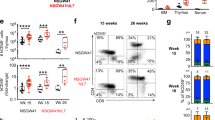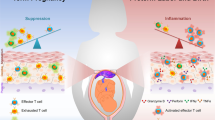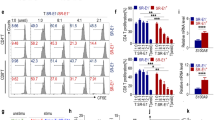Abstract
THE human fetus, as a natural allograft, escapes destruction by the maternal immune system. As a possible mechanism, Alexander1 proposed a rapid shedding of transplantation antigens by embryonic cells, resulting in a blindfolding of the otherwise fully functional maternal immune system. Other investigators have reported a suppressive activity of lymphoid cells from human cord blood on the proliferation of maternal lymphocytes2,3. Suppressor T cells are induced by α-fetoprotein in mice4, and the elevated levels of α-fetoprotein during pregnancy have been shown to exert an immunosuppressive influence in mice5,6 and in man7. Olding8 demonstrated a soluble factor from mitogen stimulated lymphoid cells of human newborns suppressing the proliferation of maternal lymphocytes. These observations point out that the embryo might protect itself by release of soluble factors, acting either themselves as lymphocyte suppressive agents, and/or by the induction of suppressor cells. However, no direct evidence has so far been presented to show the presence and action of T-cell suppressor cells in the immune system of pregnant women. Such an experiment would have to use components of the immune system of pregnant women solely, and therein demonstrate an immune suppression as compared to non-pregnant individuals. We present here results indicating that the ability of T cells from pregnant women to proliferate in soft agar cultures is strongly inhibited, regardless of the source of the serum being used in the assay, thus pointing rather to a cell-mediated suppressor mechanism.
This is a preview of subscription content, access via your institution
Access options
Subscribe to this journal
Receive 51 print issues and online access
$199.00 per year
only $3.90 per issue
Buy this article
- Purchase on Springer Link
- Instant access to full article PDF
Prices may be subject to local taxes which are calculated during checkout
Similar content being viewed by others
References
Alexander, P. Cancer Res. 34, 2077–2082 (1974).
Olding, L. B., & Oldstone, M. B. A. J. Immun. 116, 682–686 (1976).
Oldstone, M. B. A., Tishon, A. & Moretta, L. Nature 269, 333–335 (1977).
Murgita, R. A., Goidl, E. A., Kontiainen, S. & Wigzell, H. Nature 267, 257–259 (1977).
Zimmermann, E. F., Voorting-Hawking, M. & Michael, J. G. Nature 265, 354–356 (1977).
Murgita, R. A. Scand. J. Immun. 5, 1003–1014 (1976).
Auer, I. O. & Kress, H. G. Cell Immun. 30, 173–180 (1977).
Olding, L. B., Murgita, R. A. & Wigzell, H. J. Immun. 119, 1109–1114 (1977).
Böyum, A. Scand. J. clin. Lab. Invest. 21, Suppl. 97, 77 (1968).
Cunningham-Rundles, S. Clin. Immunobiology Vol. 3 (eds Bach, F. H. & Good, R. A.) 151–195 (Academic, New York, 1968).
Aiuti, F. et al. J. clin. Immun. Immunopath. 3, 584–597 (1975).
Rosenszajn, L. A., Shoham, D. & Kalechman, I. Immunology 29, 1041–1055 (1975).
Fibach, E., Gerassi, E. & Sachs, L. Nature 259, 127–128 (1976).
Author information
Authors and Affiliations
Rights and permissions
About this article
Cite this article
STAHN, R., FABRICIUS, HÅ. & HARTLEITNER, W. Suppression of human T-cell colony formation during pregnancy. Nature 276, 831–832 (1978). https://doi.org/10.1038/276831a0
Received:
Accepted:
Published:
Issue Date:
DOI: https://doi.org/10.1038/276831a0
This article is cited by
-
Steroid economising effects of a calf thymus extract in three patients with juvenile chronic arthritis
Klinische Wochenschrift (1983)
-
Impaired T-lymphocyte colony formation by cord blood mononuclear cells
Journal of Clinical Immunology (1982)
Comments
By submitting a comment you agree to abide by our Terms and Community Guidelines. If you find something abusive or that does not comply with our terms or guidelines please flag it as inappropriate.



